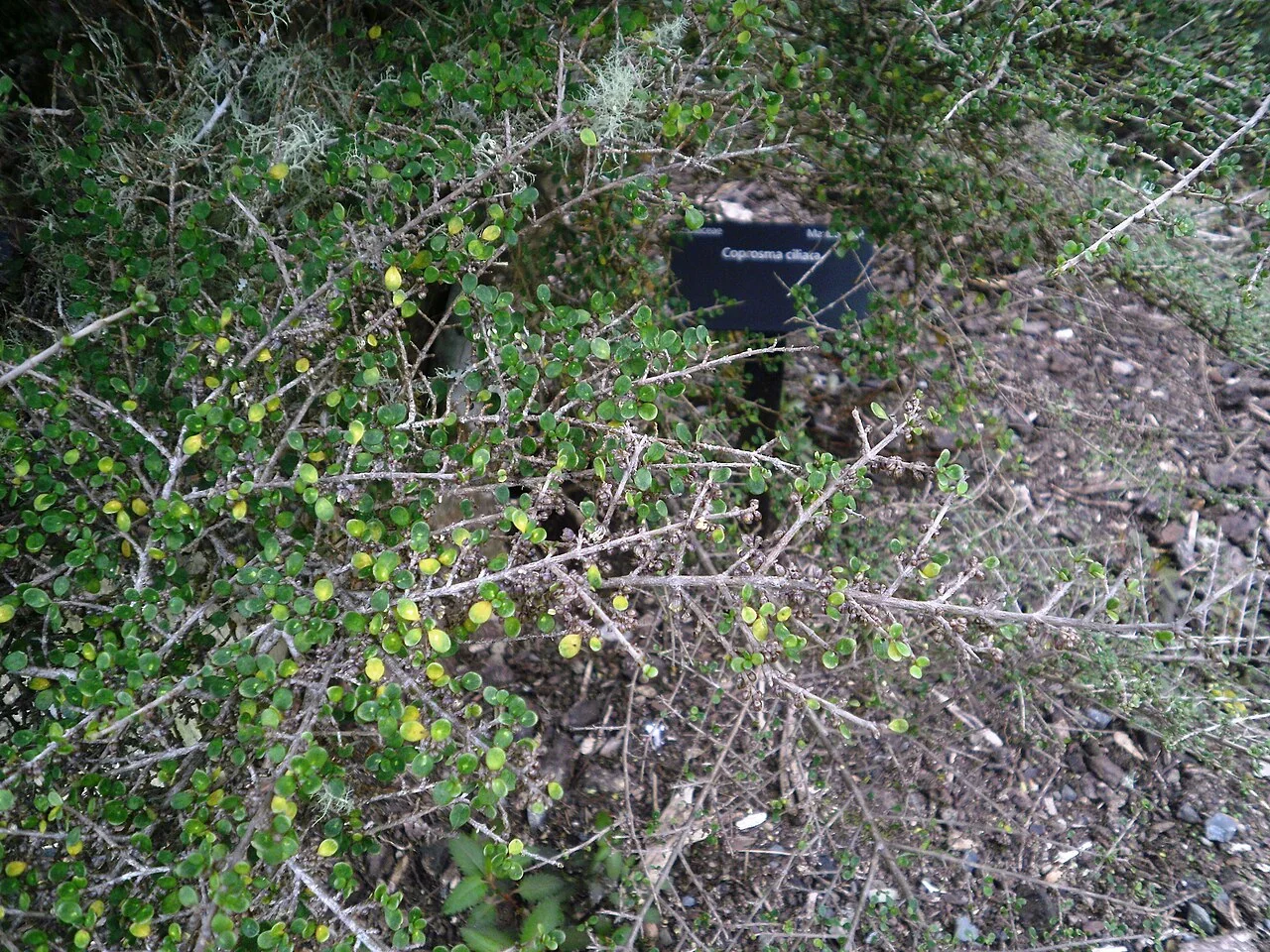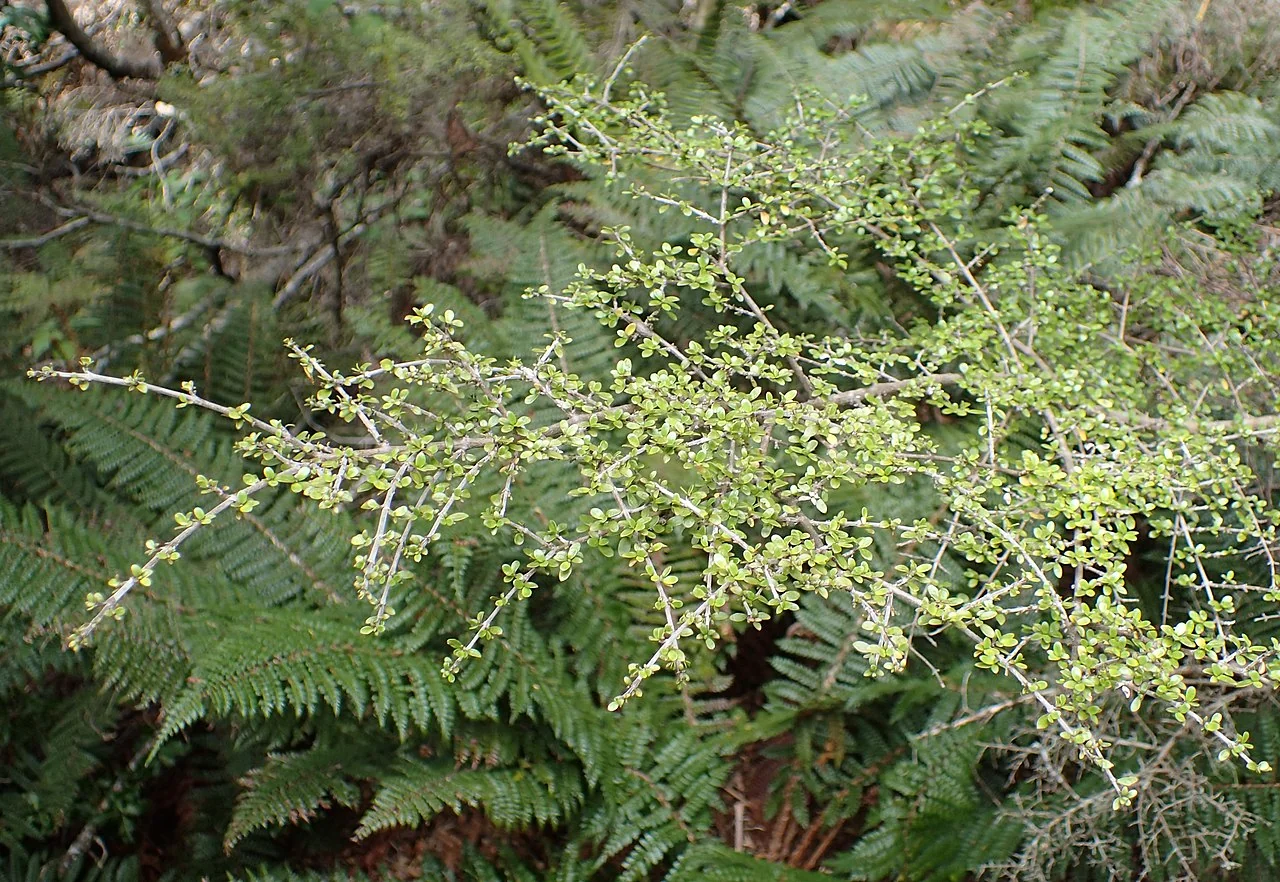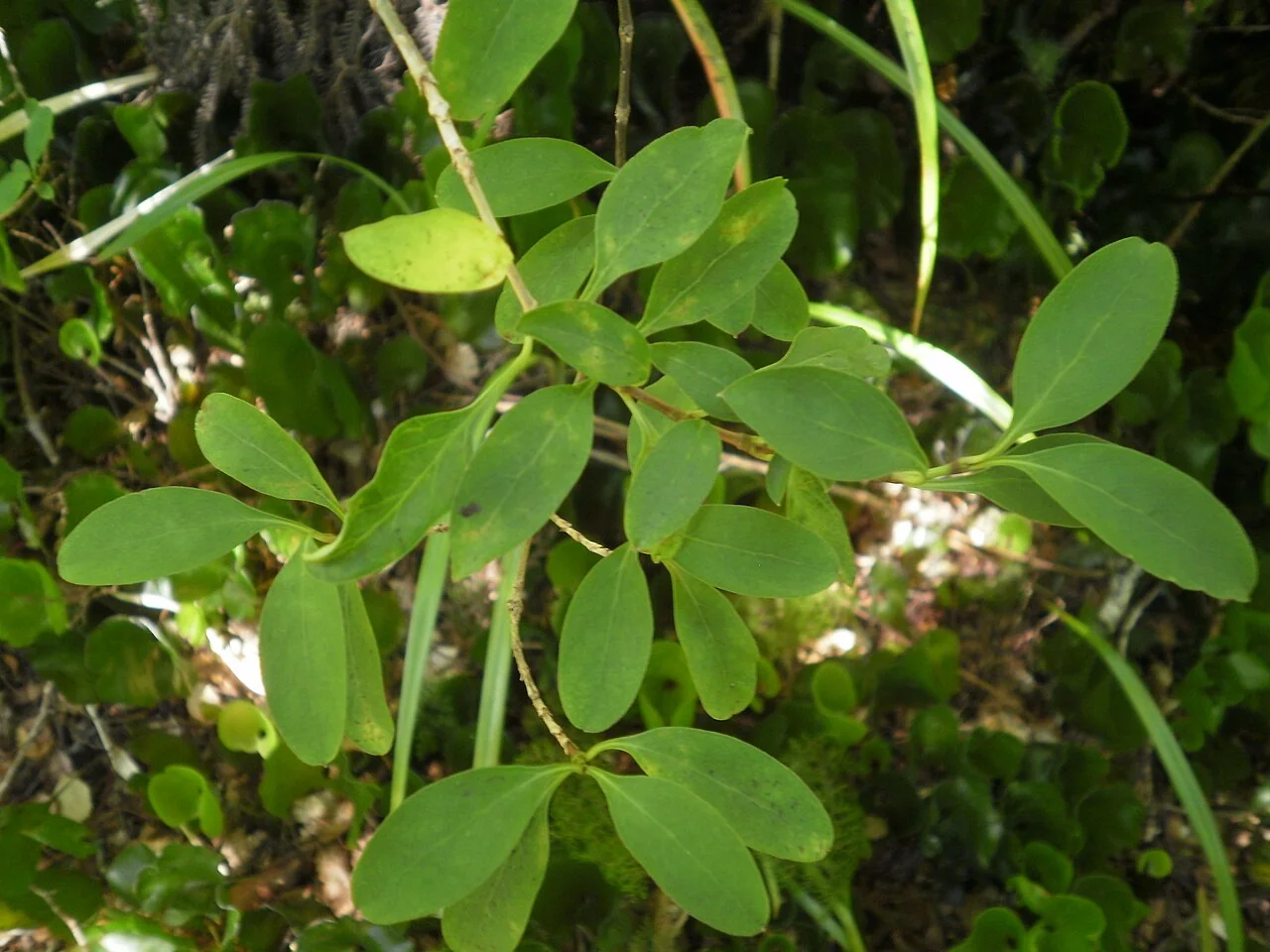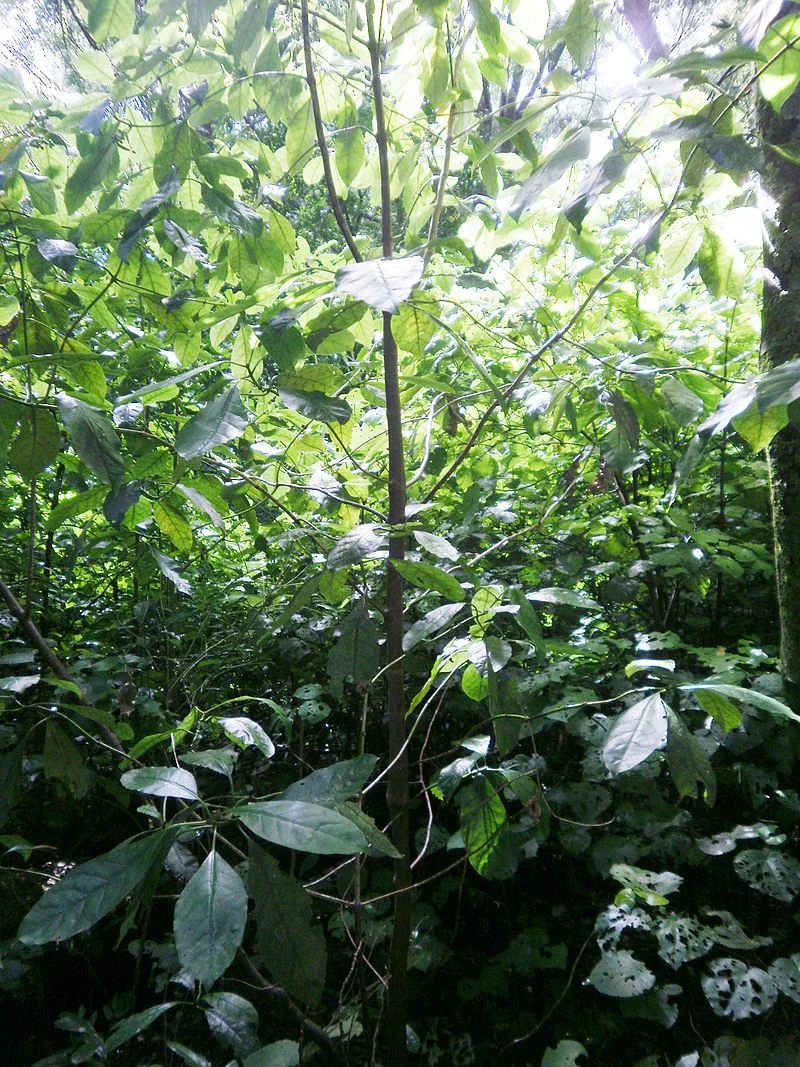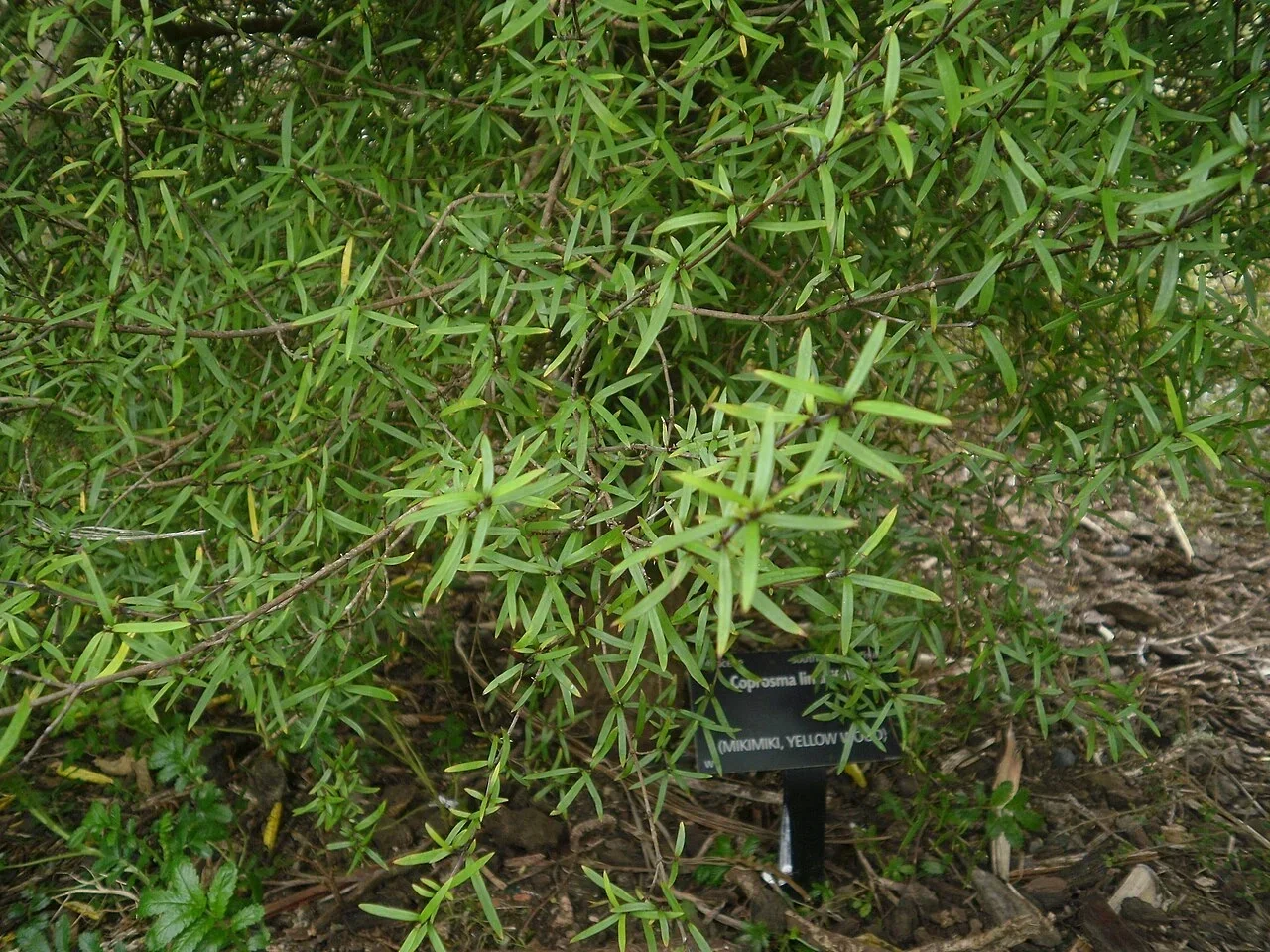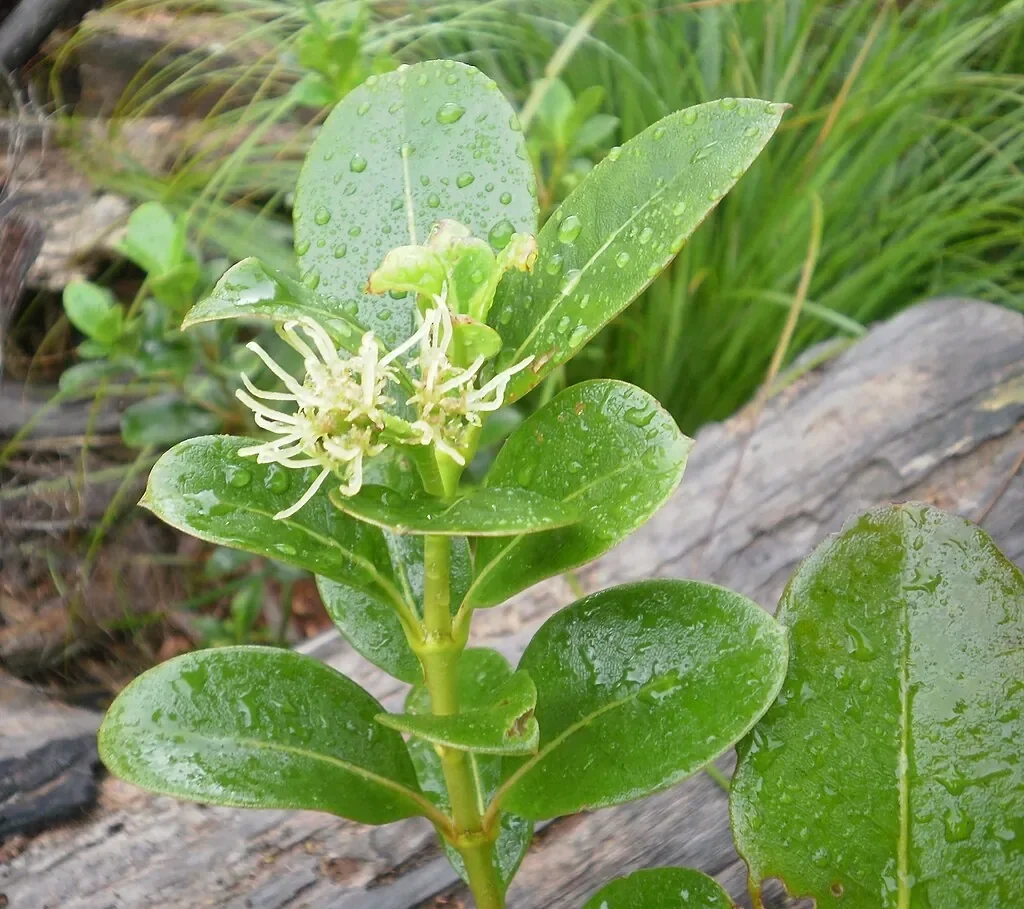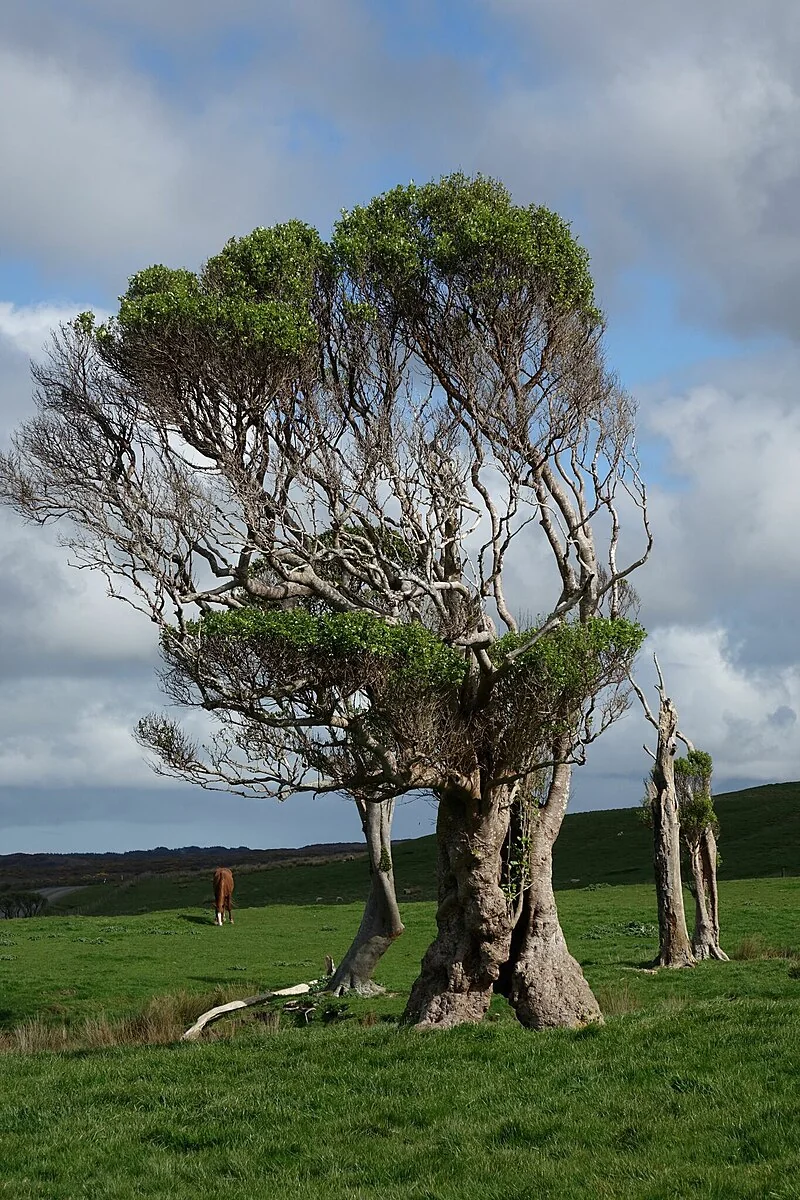
Chatham Islands Coprosma
Coprosma chathamica
Coprosma chathamica , commonly known as Chatham Island karamū, is a species among New Zealand's native trees endemic to the Chatham Islands of New Zealand. It is a large canopy tree that can grow up to 15 meters (49 feet) tall, with a trunk diameter of up to 600 mm. It has pairs of oval leaves. Juvenile leaves are larger, measuring 45-75 mm by 20-45 mm, dark green to green, broadly ovate to ovate-oblong, with often hairy margins. Adult leaves are smaller, 20-35 mm by 15-30 mm, dark green and glossy above, paler below, and can be ovate to ovate-oblong or elliptic to oblong-elliptic, often with slightly recurved or distinctly undulose margins. The flowers are green. The ripe fruit is yellow to yellow-red or orange, obovoid, and measures approximately 9-12 mm by 9-14 mm. Coprosma chathamica is a major forest tree on the Chatham Islands, found in both coastal and inland forests. It typically grows in peaty or waterlogged soils but can also be found on limestone, schist, and basalt outcrops in free-draining areas.

Plant Description
Botanical Features
Coprosma chathamica , commonly known as Chatham Islands Coprosma or Chatham Island karamū, is a large canopy tree endemic to the Chatham Islands of New Zealand. It can grow up to 15 meters tall with a trunk diameter of up to 600 mm. It has pairs of oval leaves; juvenile leaves are larger (45-75 mm by 20-45 mm) and often hairy, while adult leaves are smaller (20-35 mm by 15-30 mm), dark green, glossy, and often have wavy margins. The flowers are green and inconspicuous. The ripe fruit is yellow to yellow-red or orange, obovoid, and measures approximately 9-12 mm by 9-14 mm. This species is a major forest tree on the Chatham Islands, found in both coastal and inland forests, and can grow in peaty, waterlogged soils as well as on free-draining outcrops.
Quick Facts
Plant Specifications
| Scientific Name | Coprosma chathamica |
|---|---|
| Common Name | Chatham Islands Coprosma, Chatham Island Karamū |
| Family | Rubiaceae |
| Height | 3-6 m in cultivation |
| Spread | 2-4 m |
| Water Needs | Moderate, salt and wind tolerant |
| Light | Full sun to partial shade |
| Frost Tolerance | Hardy to -8°C |
| Salt Tolerance | High; excellent for coastal conditions |
| Growth Rate | Moderate |
| Lifespan | Long |
Climate Best Suited to
White maire (Nestegis lanceolata) is primarily found in lowland to hilly forests across the North Island of New Zealand, extending to the Marlborough Sounds in the South Island. It demonstrates good adaptability to various conditions, thriving in areas with well-drained soils and tolerating both full sun and partial shade. Its natural distribution suggests a preference for warmer, more humid environments but with a reasonable tolerance for cooler temperatures found in its southern range.
Regional Suitability
| City | Climate Suitability |
|---|---|
| Whangārei | Ideal |
| Auckland | Ideal |
| Hamilton | Ideal |
| Tauranga | Ideal |
| Rotorua | Ideal |
| Gisborne | Ideal |
| New Plymouth | Ideal |
| Napier | Ideal |
| Whanganui | Ideal |
| Palmerston North | Ideal |
| Wellington | Ideal |
| Nelson | Ideal |
| Christchurch | Ideal |
| Dunedin | Moderate |
| Invercargill | Moderate |
Natural Habitat
Chatham Islands Environment
Understand the highly specialized natural habitat of Chatham Islands Coprosma (Coprosma chathamica), including its endemic distribution on the Chatham Islands, specific environmental requirements, and the unique island ecosystems where it thrives. This knowledge is essential for successful cultivation and conservation.
- Endemic distribution limited to the Chatham Islands archipelago.
- Specialized island forest and coastal shrubland habitat preferences.
- Associated endemic plant communities and typical island ecosystem companions.
Plant Conservation
As of 2023, Coprosma chathamica is classified as "At Risk - Naturally Uncommon" with qualifiers "IE" (Island Endemic) and "RR" (Range Restricted). This species is endemic to the Chatham Islands, where it is one of the major forest trees and is not considered truly threatened.
Growing Requirements
Soil Requirements
White maire (Nestegis lanceolata) is remarkably adaptable to different soil conditions, thriving in well-drained environments. It can tolerate a variety of soil types, from sandy to loamy, and prefers a neutral to slightly acidic pH. Good drainage is crucial to prevent root rot, ensuring healthy growth and development.
- Tolerates a wide range of soil types from clay to sandy
- Prefers well-draining soils but can handle occasional waterlogging
- Thrives in moderately fertile soils but will grow in poor soils too
- Can tolerate slightly acidic to slightly alkaline pH
- Handles coastal conditions including salt spray
Light Requirements
White maire (Nestegis lanceolata) thrives in a variety of light conditions, from full sun to partial shade. Optimal growth and flowering are typically achieved in locations receiving ample sunlight throughout the day. However, it can also tolerate some shade, especially in hotter climates, where it benefits from protection during the most intense afternoon sun.
- Full sun for optimal growth and form
- Can tolerate partial shade but may develop a leggier form
- At least 6 hours of direct sunlight daily is ideal
- Northern or eastern exposures work well in garden settings
Water Requirements
Once established, White maire (Nestegis lanceolata) is remarkably drought-tolerant, requiring minimal supplemental watering. During its establishment phase, consistent moisture is crucial to encourage strong root development. Mature plants can withstand dry periods, but regular watering during prolonged droughts will promote healthier growth and more abundant flowering.
- Moderate watering during establishment (first 1-2 years)
- Drought-tolerant once established
- Can handle periods of soil saturation
- Reduce watering in winter when growth slows
- Signs of overwatering include yellowing leaves and crown rot
Planting Guide
-
Best Time to Plant
Plant in autumn or spring when soil conditions are mild and moisture is adequate. This allows the tree to establish strong roots before facing summer heat or winter cold.
-
Choosing a Location
Select a site with well-drained soil and good air circulation. This species thrives in exposed locations and coastal conditions. Allow adequate space for its mature size and spreading habit.
-
Planting Steps
Dig a hole twice the width of the root ball. Incorporate compost if soil is poor. Place the plant at the same depth as in the pot. Backfill with soil, firm gently, and water thoroughly. Mulch lightly to conserve moisture.
Ecological Significance
Ecosystem Roles
Chatham Islands Coprosma ( Coprosma chathamica ) plays a vital role in the unique ecosystems of the Chatham Islands, serving as both a crucial food source for endemic wildlife and an important structural component of island forest and shrubland communities.
- Translucent berries provide essential food for Chatham Islands endemic birds
- Flowers attract specialized island pollinators and beneficial insects
- Dense foliage provides crucial nesting sites for endemic bird species
- Important component of Chatham Islands forest and coastal shrubland ecosystems
- Helps stabilize coastal soils and provides wind protection in exposed island environments
Uses and Significance
Garden Uses
- Specimen tree for visual impact
- Suitable for native gardens and restoration projects
- Enhances native garden aesthetics and biodiversity
- Provides architectural accent with its unique structure
- Effective for erosion control on slopes and banks
Ecological Value
Ecologically, White maire (Nestegis lanceolata) plays a crucial role in supporting native ecosystems. Its fruits are a food source for birds, especially the kereru, contributing to the local biodiversity and food web.
- Provides a vital food source for native birds, especially the kereru
- Offers habitat and nesting sites for various fauna
- Contributes to soil stabilization and nutrient cycling
- Forms natural shelter belts, protecting other species
Landscaping Applications
Conservation Landscaping
Discover how Chatham Islands Coprosma ( Coprosma chathamica ) can be effectively integrated into specialized landscaping designs. This section offers expert advice for using this rare endemic tree in appropriate garden settings while respecting its conservation importance.
- Design ideas for coastal gardens and wind-exposed locations.
- Best uses in conservation collections, botanical gardens, and specialized plantings.
- Creating appropriate conditions for this unique island endemic.
Seasonal Care Calendar
Spring
In spring, White maire (Nestegis lanceolata) begins its active growth phase. New foliage emerges, and it's an ideal time for planting new specimens or propagating. Ensure adequate moisture and monitor for early signs of pests.
- New growth begins with fresh foliage development
- Apply a balanced, slow-release fertilizer if desired
- Excellent time for planting new specimens or dividing offsets
- Monitor for new pest activity and address promptly
Summer
Summer is the peak growing season for White maire (Nestegis lanceolata), often accompanied by flowering. Consistent watering is important, especially for young plants, to support vigorous growth and prevent stress during dry periods.
- Flowering typically occurs in early to mid-summer (November-January)
- Water young trees regularly during extended dry periods
- Avoid heavy pruning during the active growing season
Autumn
During autumn, White maire (Nestegis lanceolata) prepares for the cooler months. Fruits or berries develop, providing food for native birds. It's also a good time for planting and general garden cleanup.
- Fruits or berries develop and ripen (December-February), attracting birds
- Natural leaf shedding occurs as part of its growth cycle
- Good time for planting new specimens to establish before winter
- Clean up fallen leaves if a tidy appearance is desired
Winter
Winter is generally a dormant period for White maire (Nestegis lanceolata). Minimal care is required, though young plants may benefit from protection in colder regions. This is an opportune time for any necessary structural pruning.
- Generally dormant with minimal growth activity
- No special winter protection needed in most mild climates
- Suitable time for structural pruning if required
- Fallen leaves can be left as mulch or removed for tidiness
When to Prune and How Much
White maire (Nestegis lanceolata) generally requires minimal pruning to maintain its natural form and health. Pruning should focus on removing dead or damaged growth and shaping the plant as needed.
- Remove dead, damaged, or diseased branches at any time of year
- Light formative pruning when young helps establish good structure
- To create a multi-trunked specimen, cut the main stem to encourage branching
- Fallen leaves can be removed for a tidier appearance, or left as natural mulch
- If necessary, lower branches can be removed to create clearance underneath
- Major pruning is best done in late winter to early spring before new growth
Always use clean, sharp tools for pruning to minimize the risk of disease and ensure clean cuts. The plant often responds well to pruning with vigorous new growth, contributing to a fuller, healthier appearance.
How to Grow Chatham Islands Coprosma
From Conservation Seeds
Conservation seed propagation represents the most crucial and authentic method for growing Chatham Islands Coprosma, preserving the precious genetic heritage of this remarkable endemic species while contributing to urgent conservation efforts for one of New Zealand's most geographically restricted plants. This exceptional island endemic produces distinctive translucent orange to red berries that provide vital opportunities for maintaining genetic diversity and expanding populations of a species classified as "At Risk - Naturally Uncommon" due to its extremely limited natural distribution. The species' restriction to the remote Chatham Islands archipelago makes every successful propagation effort a valuable contribution to preserving unique evolutionary adaptations developed over millennia of island isolation. Fresh seeds from conservation sources provide the highest germination success while maintaining the authentic genetic characteristics essential for preserving this distinctive island flora that has no equivalent anywhere else in the world. Obtain seeds exclusively from reputable conservation organizations, botanical gardens, or established cultivation programs that maintain detailed records of genetic provenance and source population information essential for preserving the remaining genetic diversity of this geographically restricted species. Collect ripe berries during the natural fruiting season when they have achieved their characteristic translucent orange to red coloration and can be easily removed from branches, timing collection to ensure maximum seed viability while respecting the species' important role in providing food for endemic Chatham Islands wildlife. Process berries immediately after collection by removing all flesh through thorough washing in clean water, using gentle rubbing techniques to separate seeds from fruit material that could inhibit germination or promote fungal growth during the establishment process. Clean seeds completely by repeated washing until all fruit debris is removed, retaining the viable seeds while discarding any floating material that typically indicates poor viability or damage that could compromise successful germination. Prepare specialized germination medium that replicates the free-draining yet moisture-retentive conditions of Chatham Islands soils, using well-draining seed-raising mix enhanced with organic matter and ensuring pH levels between 6.0-7.0 that support healthy development for this unique island species. Sow fresh seeds immediately after processing, placing them on the surface of moist growing medium or covering lightly with 2-3mm of fine sand, as they benefit from light exposure during germination while requiring protection from drying out during the critical establishment period. Provide optimal environmental conditions including consistent temperatures between 15-18°C and bright, indirect light that replicates the cool, oceanic conditions of the Chatham Islands where this species has evolved specialized adaptations for island survival. Maintain careful moisture management throughout the 4-8 week germination period, ensuring growing medium remains consistently moist but never waterlogged while monitoring for the early emergence that signals successful germination of this precious genetic material. Young seedlings develop slowly while establishing the robust root systems necessary for adaptation to the challenging oceanic conditions that characterize their island home, requiring protection from environmental stress during the vulnerable establishment phase when proper care determines long-term survival success. Transplant successful seedlings with extreme care when they reach sufficient size to handle garden conditions, providing specialized growing environments that accommodate their unique island adaptations while supporting their transition to cultivation conditions that honor their conservation importance.
From Island-Adapted Cuttings
Island-adapted cutting propagation offers a specialized vegetative method for growing Chatham Islands Coprosma that preserves the exact genetic characteristics of exceptional parent plants while accommodating the unique challenges of propagating a species evolved for extreme island conditions. This approach is particularly valuable for maintaining superior specimens that demonstrate enhanced adaptation to cultivation conditions, exceptional ornamental characteristics, or other traits that can be preserved through careful vegetative propagation techniques specifically adapted for this challenging endemic species. The method requires advanced understanding of island plant physiology and specialized techniques developed for species adapted to harsh oceanic environments where traditional propagation methods often fail. Take semi-hardwood cuttings during late summer to early autumn when current season's growth has achieved optimal maturity for rooting while retaining the vigor necessary for successful establishment under controlled propagation environments that replicate island conditions. Select healthy, vigorous shoots from parent plants that demonstrate the best adaptation to cultivation conditions, choosing material from branches that display the characteristic thick, glossy leaves and robust growth typical of healthy Chatham Islands Coprosma development in garden settings. Cut sections 10-15cm in length with clean, sterilized secateurs, ensuring each cutting includes at least 2-3 nodes while selecting material that represents the superior characteristics of parent plants including wind tolerance, compact growth habit, and healthy foliage development. Remove lower leaves carefully to reduce transpiration stress while retaining sufficient photosynthetic capacity in upper leaves, taking special care not to damage the distinctive thick, glossy foliage that characterizes this species and provides the energy reserves necessary for successful root development. Apply specialized rooting hormone formulated for difficult-to-root native species immediately after preparation, using concentrations and formulations that have proven successful with related island endemics while ensuring even coverage of cut surfaces where new root systems must develop. Insert prepared cuttings into meticulously prepared cutting mix composed of specialized propagation medium with exceptional drainage characteristics, incorporating coarse sand, perlite, and quality organic matter to replicate the well-draining yet moisture-retentive soils of the Chatham Islands. Maintain optimal environmental conditions including high humidity (80-90%) and consistent cool temperatures around 16-18°C using specialized propagation facilities that provide the precise oceanic climate conditions essential for success with this island-adapted species. Provide bright, indirect light that supports photosynthesis without causing excessive stress, while ensuring excellent air circulation that replicates the constant oceanic breezes that characterize the natural environment of this wind-adapted species. Monitor cutting development intensively throughout the extended 8-15 week rooting period, maintaining consistent environmental conditions while watching for signs of successful root development that can be slow and variable in this challenging species. Root development occurs gradually as cuttings adapt to cultivation conditions while maintaining their island-evolved characteristics, requiring exceptional patience and specialized care throughout the establishment process that can extend over several months. This advanced method provides invaluable results for preserving specific genetic lines of this conservation-important species while contributing to breeding programs that maintain the genetic diversity essential for long-term species survival in cultivation.
From Conservation Cultivation
Conservation cultivation provides the most comprehensive and conservation-focused approach to growing Chatham Islands Coprosma, emphasizing the preservation of this unique island endemic while contributing to broader conservation efforts for Chatham Islands ecosystems and their remarkable endemic flora. This method is essential for botanical institutions, dedicated conservation programs, and serious plant collectors seeking to maintain viable populations of this geographically restricted species that represents irreplaceable evolutionary heritage from one of the world's most isolated island groups. The approach requires expert-level knowledge of island plant ecology, specialized facilities for maintaining optimal growing conditions, and deep commitment to conservation principles that honor the species' unique evolutionary history and conservation importance. Begin by establishing specialized growing environments that replicate the cool, oceanic conditions of the Chatham Islands, including consistent cool temperatures, high humidity, excellent air circulation, and protection from temperature extremes that can stress plants adapted to stable island climates. Design cultivation programs that maintain genetic diversity through careful management of multiple genetic lines sourced from different conservation programs, ensuring that cultivated populations preserve the natural variation essential for species resilience and long-term survival potential. Source plant material exclusively through legitimate conservation channels that maintain detailed genetic records and provenance documentation, ensuring contributions to authentic conservation efforts rather than potentially compromising wild populations through unauthorized collection. Establish mother plants under optimal cultivation conditions that promote vigorous growth and reproductive success, providing the plant material necessary for ongoing propagation efforts while serving as genetic reservoirs for future conservation breeding programs. Implement specialized propagation protocols that maximize success rates while maintaining genetic integrity, using both seed and vegetative propagation methods to ensure comprehensive genetic preservation and population expansion capabilities. Monitor plant health and environmental conditions continuously using specialized equipment that tracks temperature, humidity, light levels, and air circulation to maintain the precise environmental parameters essential for long-term success with this island-adapted species. Develop integrated pest and disease management programs that prevent introduction of pathogens that could devastate small conservation populations while maintaining the plant health essential for successful reproduction and genetic preservation. Maintain detailed cultivation records that document genetic lineages, propagation success rates, plant performance, and environmental conditions to contribute to broader conservation knowledge and improve cultivation techniques for this and related island endemic species. Collaborate with conservation organizations, botanical gardens, and research institutions to coordinate conservation efforts and ensure that cultivation programs contribute effectively to broader species recovery and habitat conservation initiatives. This expert-level approach requires significant investment in specialized facilities and ongoing expertise but provides irreplaceable contributions to conserving one of New Zealand's most distinctive and geographically restricted endemic species while advancing understanding of island plant conservation and cultivation techniques.
Pests and Diseases
Chatham Islands Coprosma ( Coprosma chathamica ) is generally very hardy with excellent natural resistance to most pests and diseases. Its island evolution has created robust natural defenses.
Occasional Issues
- Scale insects: May occasionally occur, particularly in stressed conditions
- Aphids: Rare, but can appear on new growth in spring
- Fungal problems: Very uncommon, mainly associated with poor drainage
Environmental Stressors
- Poor drainage: Can lead to root rot in heavy, waterlogged soils
- Extreme drought: Young plants may suffer in extended dry periods
- Severe frost: Young plants can be damaged by harsh frosts
Prevention
Success depends on providing good drainage, adequate moisture during establishment, and protection from extreme weather for young plants. Healthy trees in suitable conditions rarely experience serious problems.
Cultural Significance
Chatham Islands Coprosma, known as Chatham Island Karam-, holds cultural significance as a key species in the unique flora of the Chatham Islands. It represents the natural heritage of the islands and its berries were likely a food source for the Māoriori and early M-ori inhabitants. Its presence is a symbol of the distinct biodiversity of the Chatham Islands.
Bonus Tip
Chatham Islands Coprosma (Coprosma chathamica) is an excellent choice for coastal gardens due to its high tolerance for salt and wind. Its dense, evergreen foliage provides year-round shelter and its attractive berries are a valuable food source for native birds. This hardy tree is a great option for creating resilient, low-maintenance landscapes in challenging coastal environments.
